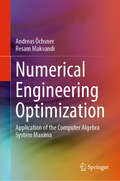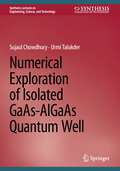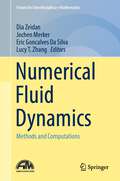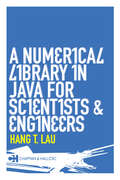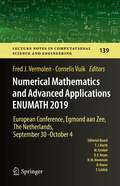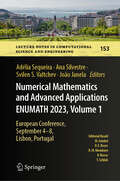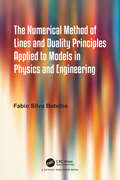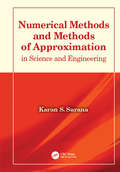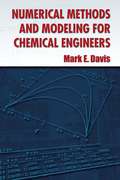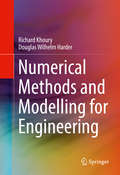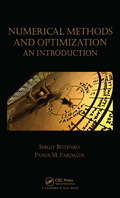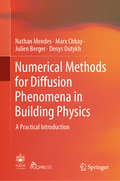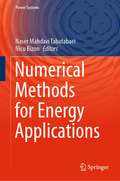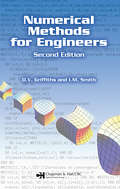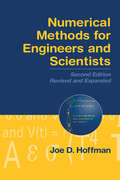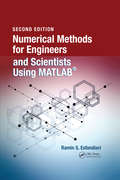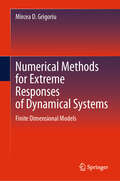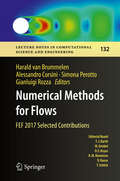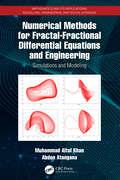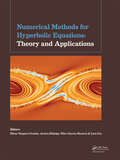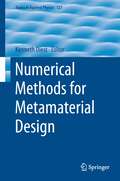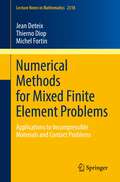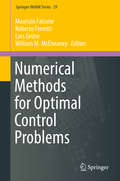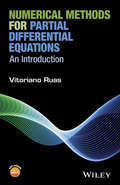- Table View
- List View
Numerical Engineering Optimization: Application of the Computer Algebra System Maxima
by Andreas Öchsner Resam MakvandiThis study aid on numerical optimization techniques is intended for university undergraduate and postgraduate mechanical engineering students. Optimization procedures are becoming more and more important for lightweight design, where weight reduction can, for example in the case of automotive or aerospace industry, lead to lower fuel consumption and a corresponding reduction in operational costs as well as beneficial effects on the environment. Based on the free computer algebra system Maxima, the authors present procedures for numerically solving problems in engineering mathematics as well as applications taken from traditional courses on the strength of materials. The mechanical theories focus on the typical one-dimensional structural elements, i.e., springs, bars, and Euler–Bernoulli beams, in order to reduce the complexity of the numerical framework and limit the resulting design to a low number of variables. The use of a computer algebra system and the incorporated functions, e.g., for derivatives or equation solving, allows a greater focus on the methodology of the optimization methods and not on standard procedures. The book also provides numerous examples, including some that can be solved using a graphical approach to help readers gain a better understanding of the computer implementation.
Numerical Exploration of Isolated GaAs-AlGaAs Quantum Well (Synthesis Lectures on Engineering, Science, and Technology)
by Sujaul Chowdhury Urmi TalukderThis book begins with the eigenvalue equation of energy and presents calculation of the energy spectrum of GaAs-AlGaAs Quantum Well using finite difference method and knowledge of potential energy profile, without using expressions for eigenfunctions, continuity of eigenfunctions, or their spatial derivatives at the two abrupt potential steps. The authors find that the results are almost the same as those obtained by solving numerically using regula falsi method, and transcendental equations that are obeyed by the energy levels, where the transcendental equations are obtained by requiring continuity of eigenfunctions and of their spatial derivatives at the two potential steps. Thus, this book confirms that it is possible to numerically calculate the energy spectrum of Quantum Well by the finite difference method when it is not correct or when it is not possible to use continuity of eigenfunctions and their spatial derivatives at the two abrupt potential steps. The authors also showthat it is possible to use the finite difference method in cases where the potential steps are non-abrupt. The book demonstrates this by calculating the energy spectrum of isolated parabolic Quantum Well of finite depth using finite difference method.
Numerical Fluid Dynamics: Methods and Computations (Forum for Interdisciplinary Mathematics)
by Dia Zeidan Jochen Merker Eric Goncalves Da Silva Lucy T. ZhangThis book contains select invited chapters on the latest research in numerical fluid dynamics and applications. The book aims at discussing the state-of-the-art developments and improvements in numerical fluid dynamics. All the chapters are presented for approximating and simulating how these methods and computations interact with different topics such as shock waves, non-equilibrium single and two-phase flows, elastic human-airway, and global climate. In addition to the fundamental research involving novel types of mathematical sciences, the book presents theoretical and numerical developments in fluid dynamics. The contributions by well-established global experts in fluid dynamics have brought different features of numerical fluid dynamics in a single book. The book serves as a useful resource for high-impact advances involving computational fluid dynamics, including recent developments in mathematical modelling, numerical methods such as finite volume, finite difference and finite element, symbolic computations, and open numerical programs such as OpenFOAM software. The book addresses interdisciplinary topics in industrial mathematics that lie at the forefront of research into new types of mathematical sciences, including theory and applications. This book will be beneficial to industrial and academic researchers, as well as graduate students, working in the fields of natural and engineering sciences. The book will provide the reader highly successful materials and necessary research in the field of fluid dynamics.
A Numerical Library in Java for Scientists and Engineers
by Hang T. LauAt last researchers have an inexpensive library of Java-based numeric procedures for use in scientific computation. The first and only book of its kind, A Numeric Library in Java for Scientists and Engineers is a translation into Java of the library NUMAL (NUMerical procedures in ALgol 60). This groundbreaking text presents procedural descr
Numerical Linear Algebra in Signals, Systems and Control
by Aurobinda Routray Paul Van Dooren Raymond H. Chan Shankar P. Bhattacharyya Vadim OlshevskyThe purpose of Numerical Linear Algebra in Signals, Systems and Control is to present an interdisciplinary book, blending linear and numerical linear algebra with three major areas of electrical engineering: Signal and Image Processing, and Control Systems and Circuit Theory. Numerical Linear Algebra in Signals, Systems and Control will contain articles, both the state-of-the-art surveys and technical papers, on theory, computations, and applications addressing significant new developments in these areas. The goal of the volume is to provide authoritative and accessible accounts of the fast-paced developments in computational mathematics, scientific computing, and computational engineering methods, applications, and algorithms. The state-of-the-art surveys will benefit, in particular, beginning researchers, graduate students, and those contemplating to start a new direction of research in these areas. A more general goal is to foster effective communications and exchange of information between various scientific and engineering communities with mutual interests in concepts, computations, and workable, reliable practices.
Numerical Mathematics and Advanced Applications ENUMATH 2019: European Conference, Egmond aan Zee, The Netherlands, September 30 - October 4 (Lecture Notes in Computational Science and Engineering #139)
by Fred J. Vermolen Cornelis VuikThis book gathers outstanding papers presented at the European Conference on Numerical Mathematics and Advanced Applications (ENUMATH 2019). The conference was organized by Delft University of Technology and was held in Egmond aan Zee, the Netherlands, from September 30 to October 4, 2019. Leading experts in the field presented the latest results and ideas regarding the design, implementation and analysis of numerical algorithms, as well as their applications to relevant societal problems.ENUMATH is a series of conferences held every two years to provide a forum for discussing basic aspects and new trends in numerical mathematics and scientific and industrial applications, all examined at the highest level of international expertise. The first ENUMATH was held in Paris in 1995, with successive installments at various sites across Europe, including Heidelberg (1997), Jyvaskyla (1999), lschia Porto (2001), Prague (2003), Santiago de Compostela (2005), Graz (2007), Uppsala (2009), Leicester (2011), Lausanne (2013), Ankara (2015) and Bergen (2017).
Numerical Mathematics and Advanced Applications ENUMATH 2023, Volume 1: European Conference, September 4-8, Lisbon, Portugal (Lecture Notes in Computational Science and Engineering #153)
by Adélia Sequeira Ana Silvestre Svilen S. Valtchev João JanelaThis book gathers outstanding papers presented at the European Conference on Numerical Mathematics and Advanced Applications, ENUMATH 2023. The conference was held in Lisbon, Portugal, in September 2023. Leading experts in the field presented the latest results and ideas regarding the design, implementation and analysis of numerical algorithms, as well as their applications to relevant societal problems. ENUMATH is a series of conferences held every two years to provide a forum for discussing basic aspects and new trends in numerical mathematics and its scientific and industrial applications, all examined at the highest level of international expertise. The first ENUMATH was held in Paris in 1995, with successive installments at various sites across Europe, including Heidelberg (1997), Jyvaskyla (1999), lschia Porto (2001), Prague (2003), Santiago de Compostela (2005), Graz (2007), Uppsala (2009), Leicester (2011), Lausanne (2013), Ankara (2015), Bergen (2017), and Egmond aan Zee (2019).
The Numerical Method of Lines and Duality Principles Applied to Models in Physics and Engineering
by Fabio Silva BotelhoThe book includes theoretical and applied results of a generalization of the numerical method of lines. A Ginzburg-Landau type equation comprises the initial application, with detailed explanations about the establishment of the general line expressions. Approximate numerical procedures have been developed for a variety of equation types, including the related algorithms and software. The applications include the Ginzburg-Landau system in superconductivity, applications to the Navier-Stokes system in fluid mechanics and, among others, models in flight mechanics. In its second and final parts, the book develops duality principles and numerical results for other similar and related models. The book is meant for applied mathematicians, physicists and engineers interested in numerical methods and concerning duality theory. It is expected the text will serve as a valuable auxiliary project tool for some important engineering and physics fields of research.
Numerical Methods and Methods of Approximation in Science and Engineering
by Karan S. SuranaNumerical Methods and Methods of Approximation in Science and Engineering prepares students and other readers for advanced studies involving applied numerical and computational analysis. Focused on building a sound theoretical foundation, it uses a clear and simple approach backed by numerous worked examples to facilitate understanding of numerical methods and their application. Readers will learn to structure a sequence of operations into a program, using the programming language of their choice; this approach leads to a deeper understanding of the methods and their limitations. The text features highlighted examples, numerous problems, and a complete Solutions Manual for instructors.
Numerical Methods and Modeling for Chemical Engineers
by Mark E. DavisThis text introduces computational tools for solving differential equation models that arise in chemical engineering: diffusion-reactions, mass-heat transfer, and fluid flow. Geared toward advanced undergraduates or graduate students of chemical engineering studying applied mathematics, the treatment focuses on numerical methods and modeling implemented in commercial mathematical software available at the time of its initial publication in 1984. The introductory-level approach outlines numerical techniques for differential equations that either illustrate a computation property of interest or form the underlying methods of a computer software package. Readers are assumed to have a basic knowledge of mathematics, and results requiring further background feature appropriate references. Each chapter includes illustrative examples, and problems at the chapter's end simulate industrial mathematics projects and form extensions of the examples. Helpful appendixes supplement the text.
Numerical Methods and Modelling for Engineering
by Richard Khoury Douglas Wilhelm HarderThis textbook provides a step-by-step approach to numerical methods in engineering modelling. The authors provide a consistent treatment of the topic, from the ground up, to reinforce for students that numerical methods are a set of mathematical modelling tools which allow engineers to represent real-world systems and compute features of these systems with a predictable error rate. Each method presented addresses a specific type of problem, namely root-finding, optimization, integral, derivative, initial value problem, or boundary value problem, and each one encompasses a set of algorithms to solve the problem given some information and to a known error bound. The authors demonstrate that after developing a proper model and understanding of the engineering situation they are working on, engineers can break down a model into a set of specific mathematical problems, and then implement the appropriate numerical methods to solve these problems.
Numerical Methods and Optimization: An Introduction (Chapman & Hall/CRC Numerical Analysis and Scientific Computing Series)
by Sergiy Butenko Panos M. PardalosFor students in industrial and systems engineering (ISE) and operations research (OR) to understand optimization at an advanced level, they must first grasp the analysis of algorithms, computational complexity, and other concepts and modern developments in numerical methods. Satisfying this prerequisite, Numerical Methods and Optimization: An Intro
Numerical Methods for Diffusion Phenomena in Building Physics: A Practical Introduction
by Nathan Mendes Marx Chhay Julien Berger Denys DutykhThis book is the second edition of Numerical methods for diffusion phenomena in building physics: a practical introduction originally published by PUCPRESS (2016). It intends to stimulate research in simulation of diffusion problems in building physics, by providing an overview of mathematical models and numerical techniques such as the finite difference and finite-element methods traditionally used in building simulation tools. Nonconventional methods such as reduced order models, boundary integral approaches and spectral methods are presented, which might be considered in the next generation of building-energy-simulation tools. In this reviewed edition, an innovative way to simulate energy and hydrothermal performance are presented, bringing some light on innovative approaches in the field.
Numerical Methods for Energy Applications (Power Systems)
by Nicu Bizon Naser Mahdavi TabatabaeiThis book provides a thorough guide to the use of numerical methods in energy systems and applications. It presents methods for analysing engineering applications for energy systems, discussing finite difference, finite element, and other advanced numerical methods. Solutions to technical problems relating the application of these methods to energy systems are also thoroughly explored. Readers will discover diverse perspectives of the contributing authors and extensive discussions of issues including:• a wide variety of numerical methods concepts and related energy systems applications;• systems equations and optimization, partial differential equations, and finite difference method;• methods for solving nonlinear equations, special methods, and their mathematical implementation in multi-energy sources;• numerical investigations of electrochemical fields and devices; and• issues related to numerical approaches and optimal integration of energy consumption.This is a highly informative and carefully presented book, providing scientific and academic insight for readers with an interest in numerical methods and energy systems.
Numerical Methods for Engineers
by D. Vaughan Griffiths I.M. SmithAlthough pseudocodes, Mathematica, and MATLAB illustrate how algorithms work, designers of engineering systems write the vast majority of large computer programs in the Fortran language. Using Fortran 95 to solve a range of practical engineering problems, Numerical Methods for Engineers, Second Edition provides an introduction to numerical methods,
Numerical Methods for Engineers and Scientists
by Joe D. Hoffman Steven FrankelEmphasizing the finite difference approach for solving differential equations, the second edition of Numerical Methods for Engineers and Scientists presents a methodology for systematically constructing individual computer programs. Providing easy access to accurate solutions to complex scientific and engineering problems, each chapter begins with objectives, a discussion of a representative application, and an outline of special features, summing up with a list of tasks students should be able to complete after reading the chapter- perfect for use as a study guide or for review. The AIAA Journal calls the book "…a good, solid instructional text on the basic tools of numerical analysis."
Numerical Methods for Engineers and Scientists Using MATLAB®
by Ramin S. EsfandiariThis book provides a pragmatic, methodical and easy-to-follow presentation of numerical methods and their effective implementation using MATLAB, which is introduced at the outset. The author introduces techniques for solving equations of a single variable and systems of equations, followed by curve fitting and interpolation of data. The book also provides detailed coverage of numerical differentiation and integration, as well as numerical solutions of initial-value and boundary-value problems. The author then presents the numerical solution of the matrix eigenvalue problem, which entails approximation of a few or all eigenvalues of a matrix. The last chapter is devoted to numerical solutions of partial differential equations that arise in engineering and science. Each method is accompanied by at least one fully worked-out example showing essential details involved in preliminary hand calculations, as well as computations in MATLAB. This thoroughly-researched resource:
Numerical Methods for Extreme Responses of Dynamical Systems: Finite Dimensional Models
by Mircea D. GrigoriuThis book constructs input finite dimensional (FD) models that are amendable for numerical calculations and provides accurate representations for responses of dynamical systems to these inputs, i.e., numerical solutions of stochastic equations. It establishes conditions under which numerical solutions of these equations deliver accurate estimates of extreme responses of dynamical systems that are needed to, for example, predict extreme weather events and design reliable aircrafts. It is intended to serve a broad audience including graduate students, researchers, engineers, scientists and applied mathematicians interested in the formulation and solutions of complex stochastic problems.
Numerical Methods for Flows: FEF 2017 Selected Contributions (Lecture Notes in Computational Science and Engineering #132)
by Gianluigi Rozza Simona Perotto Harald Van Brummelen Alessandro CorsiniThis book includes selected contributions on applied mathematics, numerical analysis, numerical simulation and scientific computing related to fluid mechanics problems, presented at the FEF-“Finite Element for Flows” conference, held in Rome in spring 2017. Written by leading international experts and covering state-of-the-art topics in numerical simulation for flows, it provides fascinating insights into and perspectives on current and future methodological and numerical developments in computational science. As such, the book is a valuable resource for researchers, as well as Masters and Ph.D students.
Numerical Methods for Fractal-Fractional Differential Equations and Engineering: Simulations and Modeling (Mathematics and its Applications)
by Muhammad Altaf Khan Abdon AtanganaThis book is about the simulation and modeling of novel chaotic systems within the frame of fractal-fractional operators. The methods used, their convergence, stability, and error analysis are given, and this is the first book to offer mathematical modeling and simulations of chaotic problems with a wide range of fractal-fractional operators, to find solutions. Numerical Methods for Fractal-Fractional Differential Equations and Engineering: Simulations and Modeling provides details for stability, convergence, and analysis along with numerical methods and their solution procedures for fractal-fractional operators. The book offers applications to chaotic problems and simulations using multiple fractal-fractional operators and concentrates on models that display chaos. The book details how these systems can be predictable for a while and then can appear to become random. Practitioners, engineers, researchers, and senior undergraduate and graduate students from mathematics and engineering disciplines will find this book of interest._
Numerical Methods for Hyperbolic Equations
by Elena Vázquez-Cendón Arturo Hidalgo Pilar García-Navarro Luis CeaNumerical Methods for Hyperbolic Equations is a collection of 49 articles presented at the International Conference on Numerical Methods for Hyperbolic Equations: Theory and Applications (Santiago de Compostela, Spain, 4-8 July 2011). The conference was organized to honour Professor Eleuterio Toro in the month of his 65th birthday. The topics cover
Numerical Methods for Metamaterial Design
by Kenneth DiestThis book describes a relatively new approach for the design of electromagnetic metamaterials. Numerical optimization routines are combined with electromagnetic simulations to tailor the broadband optical properties of a metamaterial to have predetermined responses at predetermined wavelengths. After a review of both the major efforts within the field of metamaterials and the field of mathematical optimization, chapters covering both gradient-based and derivative-free design methods are considered. Selected topics including surrogate-base optimization, adaptive mesh search, and genetic algorithms are shown to be effective, gradient-free optimization strategies. Additionally, new techniques for representing dielectric distributions in two dimensions, including level sets, are demonstrated as effective methods for gradient-based optimization. Each chapter begins with a rigorous review of the optimization strategy used, and is followed by numerous examples that combine the strategy with either electromagnetic simulations or analytical solutions of the scattering problem. Throughout the text, we address the strengths and limitations of each method, as well as which numerical methods are best suited for different types of metamaterial designs. This book is intended to provide a detailed enough treatment of the mathematical methods used, along with sufficient examples and additional references, that senior level undergraduates or graduate students who are new to the fields of plasmonics, metamaterials, or optimization methods; have an understanding of which approaches are best-suited for their work and how to implement the methods themselves.
Numerical Methods for Mixed Finite Element Problems: Applications to Incompressible Materials and Contact Problems (Lecture Notes in Mathematics #2318)
by Jean Deteix Thierno Diop Michel FortinThis book focuses on iterative solvers and preconditioners for mixed finite element methods. It provides an overview of some of the state-of-the-art solvers for discrete systems with constraints such as those which arise from mixed formulations.Starting by recalling the basic theory of mixed finite element methods, the book goes on to discuss the augmented Lagrangian method and gives a summary of the standard iterative methods, describing their usage for mixed methods. Here, preconditioners are built from an approximate factorisation of the mixed system.A first set of applications is considered for incompressible elasticity problems and flow problems, including non-linear models.An account of the mixed formulation for Dirichlet’s boundary conditions is then given before turning to contact problems, where contact between incompressible bodies leads to problems with two constraints.This book is aimed at graduate students and researchers in the field of numerical methods and scientific computing.
Numerical Methods for Optimal Control Problems (Springer INdAM Series #29)
by Maurizio Falcone Roberto Ferretti Lars Grüne William M. McEneaneyThis work presents recent mathematical methods in the area of optimal control with a particular emphasis on the computational aspects and applications. Optimal control theory concerns the determination of control strategies for complex dynamical systems, in order to optimize some measure of their performance. Started in the 60's under the pressure of the "space race" between the US and the former USSR, the field now has a far wider scope, and embraces a variety of areas ranging from process control to traffic flow optimization, renewable resources exploitation and management of financial markets. These emerging applications require more and more efficient numerical methods for their solution, a very difficult task due the huge number of variables. The chapters of this volume give an up-to-date presentation of several recent methods in this area including fast dynamic programming algorithms, model predictive control and max-plus techniques. This book is addressed to researchers, graduate students and applied scientists working in the area of control problems, differential games and their applications.
Numerical Methods for Partial Differential Equations: An Introduction
by Vitoriano RuasNumerical Methods for Partial Differential Equations: An Introduction Vitoriano Ruas, Sorbonne Universités, UPMC - Université Paris 6, France A comprehensive overview of techniques for the computational solution of PDE'sNumerical Methods for Partial Differential Equations: An Introduction covers the three most popular methods for solving partial differential equations: the finite difference method, the finite element method and the finite volume method. The book combines clear descriptions of the three methods, their reliability, and practical implementation aspects. Justifications for why numerical methods for the main classes of PDE's work or not, or how well they work, are supplied and exemplified. Aimed primarily at students of Engineering, Mathematics, Computer Science, Physics and Chemistry among others this book offers a substantial insight into the principles numerical methods in this class of problems are based upon. The book can also be used as a reference for research work on numerical methods for PDE's.Key features: A balanced emphasis is given to both practical considerations and a rigorous mathematical treatment The reliability analyses for the three methods are carried out in a unified framework and in a structured and visible manner, for the basic types of PDE's Special attention is given to low order methods, as practitioner's overwhelming default options for everyday use New techniques are employed to derive known results, thereby simplifying their proof Supplementary material is available from a companion website.
